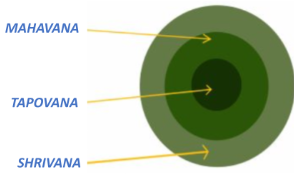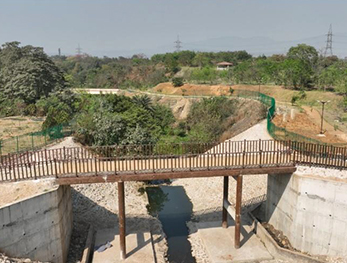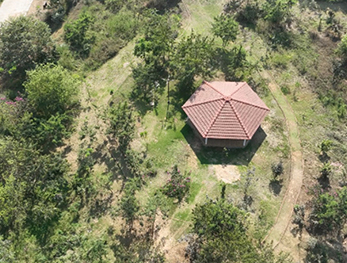About Jamshedpur Nature Trail
Jamshedpur Nature Trail is yet another milestone achieved by the Steel City towards sustainable development. The project was initiated in collaboration with Rotary Club of Jamshedpur West and Grow-trees.com, for mass plantation of 12000 trees.
Under this project, 6.8 hectares (17 acres) of land has been converted into an Urban Forest for nature lovers in Jamshedpur. The nature trail introduces a mini forest concept. This includes dense tree plantations of native species and bamboo plantations with more than 21,000 tree saplings, comprising myriad ecosystems which enhances the green cover. The project also includes wetland restoration along a 650m long rivulet cutting across this eco-park. Apart from having a walking trail, there are three viewing points (gazebo), camping sites, sun and moon garden and an FRB bridge connecting the CH area side and Marine Drive side of this Nature trail.
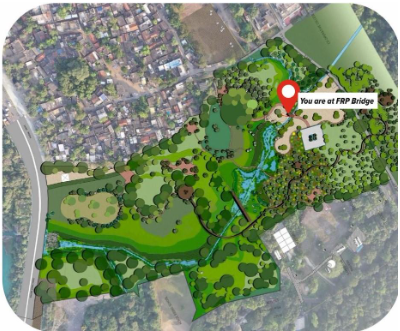
The 2.5 km meandering walking trail cuts cross the three layers with benches as resting places all along. The three layers have adequate spaces for meditation, camping, bird watching, and small group activities. The natural terrain has been retained to create different levels having a pleasant poise of densely planted zones and open grasslands where three Gazebos have been strategically located for viewing points.
Jamshedpur Nature Trail Concept
Nature trail design has been developed as three layers of tree plantation, having derived their significance from the forest classification in ancient times viz. Shrivana, Mahavana and Tapovana.
-
Shrivana - The outermost layer, closer to human settlement. This layer had the most human access and was used for fuel wood, construction wood, grazing and other products. This was in a way maintained by humans.
-
Mahavana - The second layer with lesser human intervention, where trees were not allowed to be cut, only the reproducible products like fruits, herbs, medicines, honey, etc. were allowed to be taken.
-
Tapovana - The innermost layer with the least or no human intervention, where no humans apart from sages will be allowed. It is an undisturbed layer of the forest, rich in biodiversity and this layer is responsible for maintaining the ecological balance of the forest ecosystem.
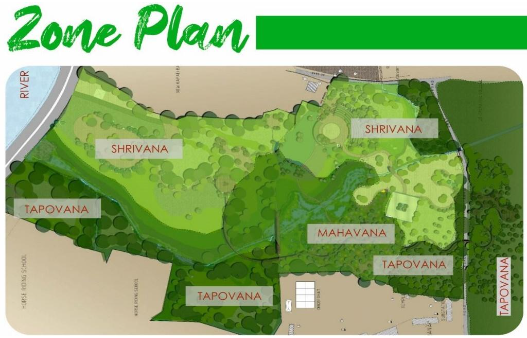
Wetland Restoration at Jamshedpur Nature Trail Concept
Wetland restoration is another key feature of this project for enhancing the native ecosystems, wherein a 650m long rivulet has been rejuvenated. Restoration treatment methods adopted a combination of microbes, sunlight, and oxygen manipulation which is found in stable streams. The main advantage of natural treatment is that it is environmentally friendly and uses natural processes to purify water. Restoration used natural materials like rock, logs, and native plants to restore the stream.
Restoration of wetland is an effort for re-establishment of pre-disturbance aquatic functions and the related physical, chemical, and biological functions that wetlands perform.
The techniques deployed are:
- Trash trap
- Riffle bed
- De-siltation
- Shallow lilly ponds
- Cascades
- Stone pitching
- Riparian trees
- Vetiver grass with reed beds as Vegetation filter strips

A mixed approach has been adopted for stabilizing the existing heaps of slag and solid waste in the area to make it conducive for tree plantations. Slope protection with coir matting coupled with wadelia plantation and slope protection with stone pitching have been carried out as per the soil investigations.
Use of Products of Tata Steel’s New Material Business
The Nature trail also showcases in-house products like NEST-IN public toilets, New Material Business Street Light posts with LED lamps and 12metre long FRP Bridge over the rivulet from Circuit House area side to the Marine drive side. These materials have been carefully designed in wooden texture to match with the surrounding environment.
 Corporate
Corporate
 Sustainability
Sustainability
 Products & Solutions
Products & Solutions
 Investors
Investors
 Media
Media
 Careers
Careers
 Contact Us
Contact Us





